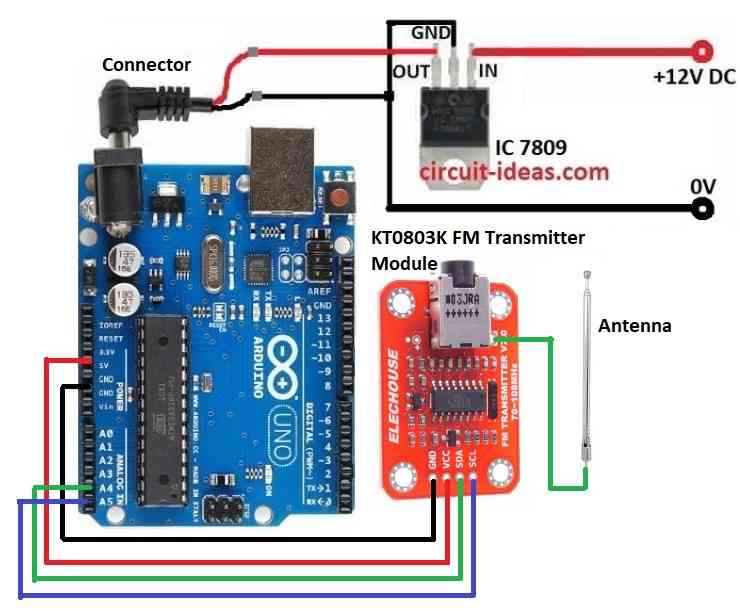The widespread radio frequency broadcasting technique known as FM (Frequency Modulation) transmission is used to transmit audio signals.
The creation of an Arduino FM transmitter has grown in popularity among enthusiasts due to the growing interest in do-it-yourself electronics projects.
Using an Arduino Uno, KT0803K FM transmitter module, 7809 voltage regulator, and a basic antenna, we will build an FM transmitter in this post.
This project lets you investigate the principles of radio transmission while also being enjoyable and informative.
Code with Explanation:
#include <Wire.h>
#define SCL_PIN A5 // Define SCL pin
#define SDA_PIN A4 // Define SDA pin
void setup() {
Serial.begin(9600);
Wire.begin(SDA_PIN, SCL_PIN); // Initialize I2C communication with specific pins
// Example of sending a command to the KT0803K
// Replace with actual commands as per your module's datasheet
Wire.beginTransmission(0xXX); // Replace 0xXX with the KT0803K I2C address
Wire.write(0x01); // Example command (modify as needed)
Wire.endTransmission();
}
void loop() {
// Add your code to handle audio input and control the KT0803K
}Explanation:
- The Wire library, which is necessary for I2C connection, is included in this line.
- It has features for writing to and reading from I2C devices.
- The Serial Clock Line, or A5, is the value of SCL_PIN.
- The Serial Data Line, or A4, is the value for SDA_PIN.
- Setup Function: Upon program startup, the setup() function is called once.
- Serial.begin(9600): This command starts the serial connection at a 9600 baud rate, enabling debugging output to the Serial Monitor.
- Wire.begin(SDA_PIN, SCL_PIN): Sets the SDA and SCL pins to initialize the I2C bus.
- At the given I2C address, Wire.beginTransmission(0xXX) initiates communication with the device (change 0xXX with the actual address of the KT0803K).
- Wire.write(0x01): Delivers an instruction to the apparatus.
- The sample command (0x01) should be changed to match the exact command you want to transmit; for further information, see the KT0803K datasheet.
- Releases the bus and ends the transmission using the call to Wire.endTransmission().
- Following the setup() function, the loop() function executes continually.
- To handle audio input, control FM transmission, or implement any other functionality you wish to use with the KT0803K, enter your code here.
Circuit Working:

Parts List:
The Arduino and the KT0803K have a dependable power source thanks to the IC 7809, which controls the input voltage to a steady 9V.
Acting as the microcontroller, the Arduino Uno manages the transmission process.
Data is sent to the KT0803K module by it.
The transmitters core is the KT0803K module.
It transforms data into FM radio waves after receiving it from the Arduino.
The module features pins for connecting the antenna, power supply, and data input.
The FM radio waves are broadcast using a antenna.
It is possible to modify the antennas length to maximize signal quality and transmission range.
How to Build:
To build a Simple Arduino FM Transmitter Circuit follow the below mentioned steps for connections:
- Gather all the components as mentioned in the above circuit diagram.
- Connect a regulated IC 7809 to provide a regulated 9V DC to the Arduino board as per the above circuit diagram
- Connect KT0803K FM Transmitter Module GND pin to GND pin on Arduino board
- Connect KT0803K FM Transmitter Module VCC pin to 5V pin on Arduino board
- Connect KT0803K FM Transmitter Module SDA pin to A4 pin on Arduino board
- Connect KT0803K FM Transmitter Module SCL pin to A5 pin on Arduino board
- Connect Antenna to KT0803K FM Transmitter Module antenna point as shown in above circuit diagram
Conclusion:
Using an Arduino Uno and the KT0803K module to build an FM transmitter is a fun project that improves your knowledge of radio communication.
The projects simplicity makes assembling simple, but it also provides opportunities for additional research into topics like frequency modulation methods and audio quality enhancement.
Always make sure you are in accordance with the law by checking your local legislation regulating FM transmission.
Have fun sending out your audio signals!
Leave a Reply